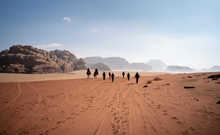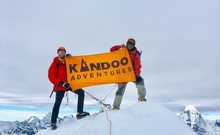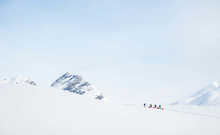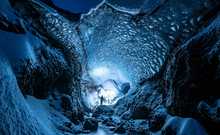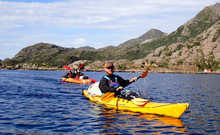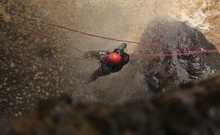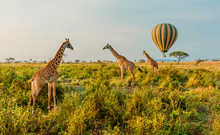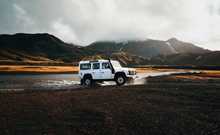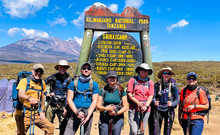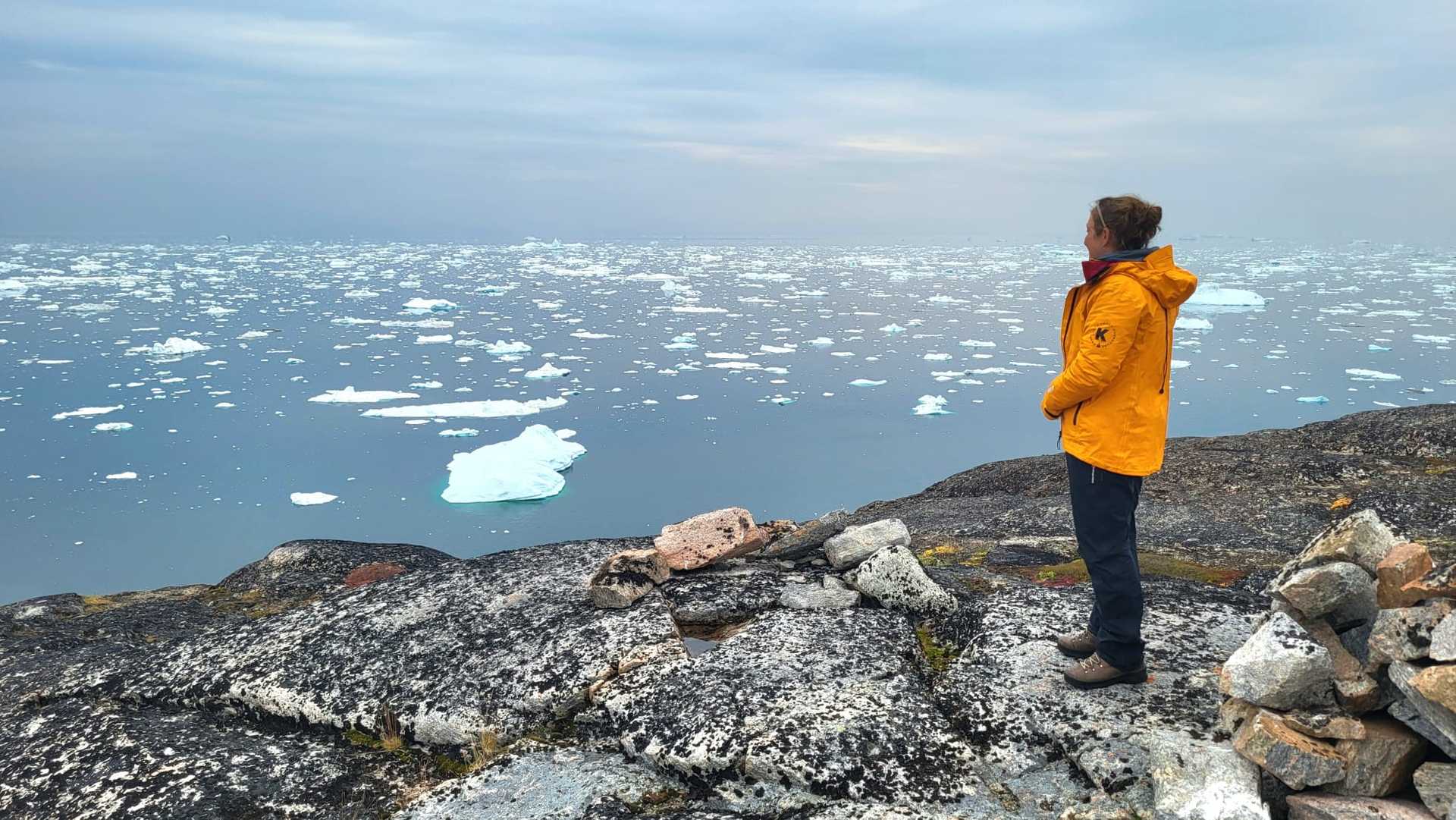Going solo or joining a guided trek – how to choose the best fit for you
If you’re reading this article, you’re probably thinking about heading out on a big adventure – and that’s really exciting! But when it comes to planning a trip, it’s hard to know whether to handle all the logistics yourself or join a pre-planned trekking group to relieve some of that pressure.
Both options have pros and cons worth considering. Planning a trip yourself gives you the freedom and flexibility to go where you want. Joining group hiking trips means less planning, more security, and access to expert knowledge from local guides.
So which option is right for you?
Choosing the right type of trip depends on what you want to get out of it, how much planning and preparation you’re willing to invest, and your budget.
To help you make the right decision, this article outlines everything you need to know about self-guided walking tours versus group travel. We explain the key differences and what you need to consider when choosing the best option for your trip.
Key takeaways
- A self-guided walking tour is flexible, independent, and usually more cost-effective. Guided treks are structured, supported, and integrate unique local insight from experienced guides.
- Book a self-guided tour if you want total freedom over your route, enjoy solitude, and don’t mind handling logistics and carrying your own gear.
- Book guided hiking tours if you want the convenience of pre-planned logistics, the safety and expertise of local guides, the chance to share your adventure with like-minded travellers and build lifelong friendships.
- Book your next trip with Kandoo to make the most of your adventure without the stress of planning. We take care of all the details, provide expert guides trained in safety and altitude management, and help you make the most out of your adventure.
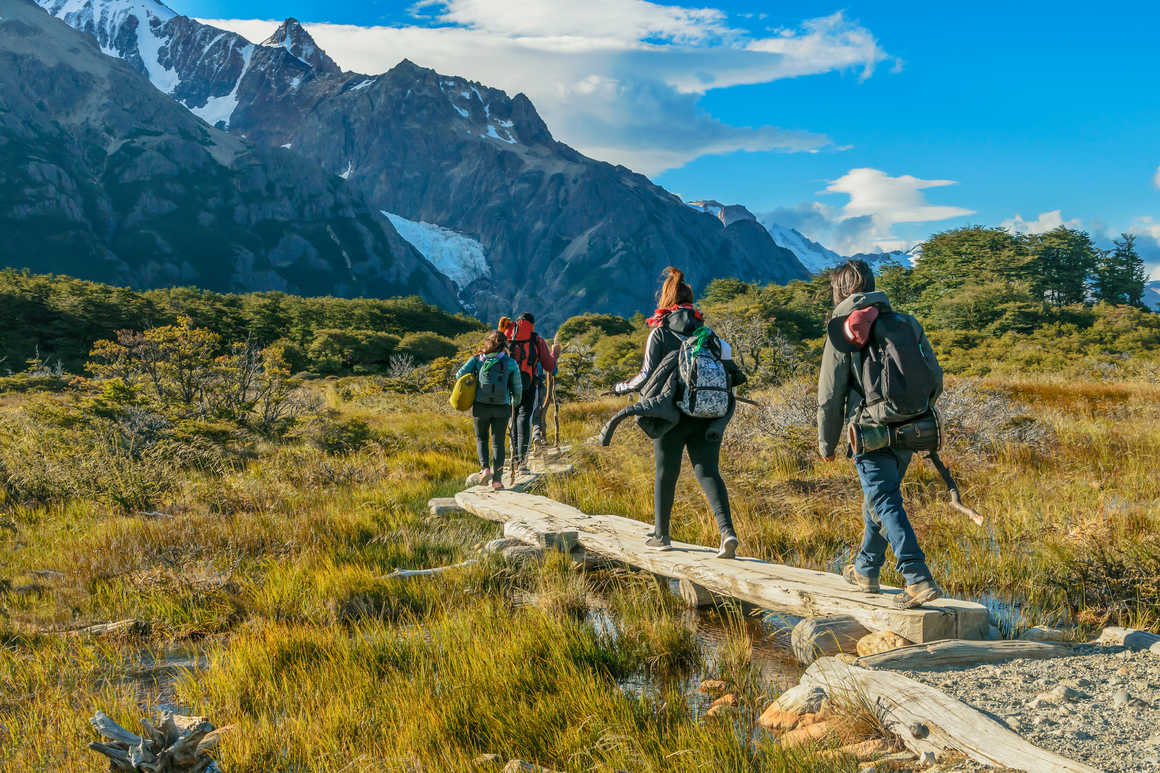
Self-guided versus guided treks: What’s the difference?
To help you choose between a self-guided and a guided hiking trip, let’s start by clarifying the difference:
- A self-guided trek involves planning the trip entirely yourself, maps and all. You’re the one plotting the route, booking refuges, planning stops, preparing food, carrying all your gear, and physically getting yourself from A to B.
- A guided trek involves heading out in a group with a mountain guide. You don’t do any planning or logistics – you simply book the trip, show up, and follow the leader.
Well, technically there’s more to it than that. Depending on the trek you choose, you’ll have to do some preparation and training beforehand.
For example, if you book a trek in Nepal with Kandoo, we ask that you follow our Nepal training guide to prepare your body for the expedition. You may also need to buy or hire some clothing and equipment for the trip.
But the same goes for solo trips. You still need to prepare your body for what you’re going to do – it’s self-directed rather than guided by a tour operator’s pre-planned programme.
Planning your trek: 6 things to consider before going solo or guided
Understanding how self-guided and guided treks work is the first part of the puzzle. Now, you need to think about what you want from your hiking trip and which format works best.
Here’s a quick overview of the key things to think about:
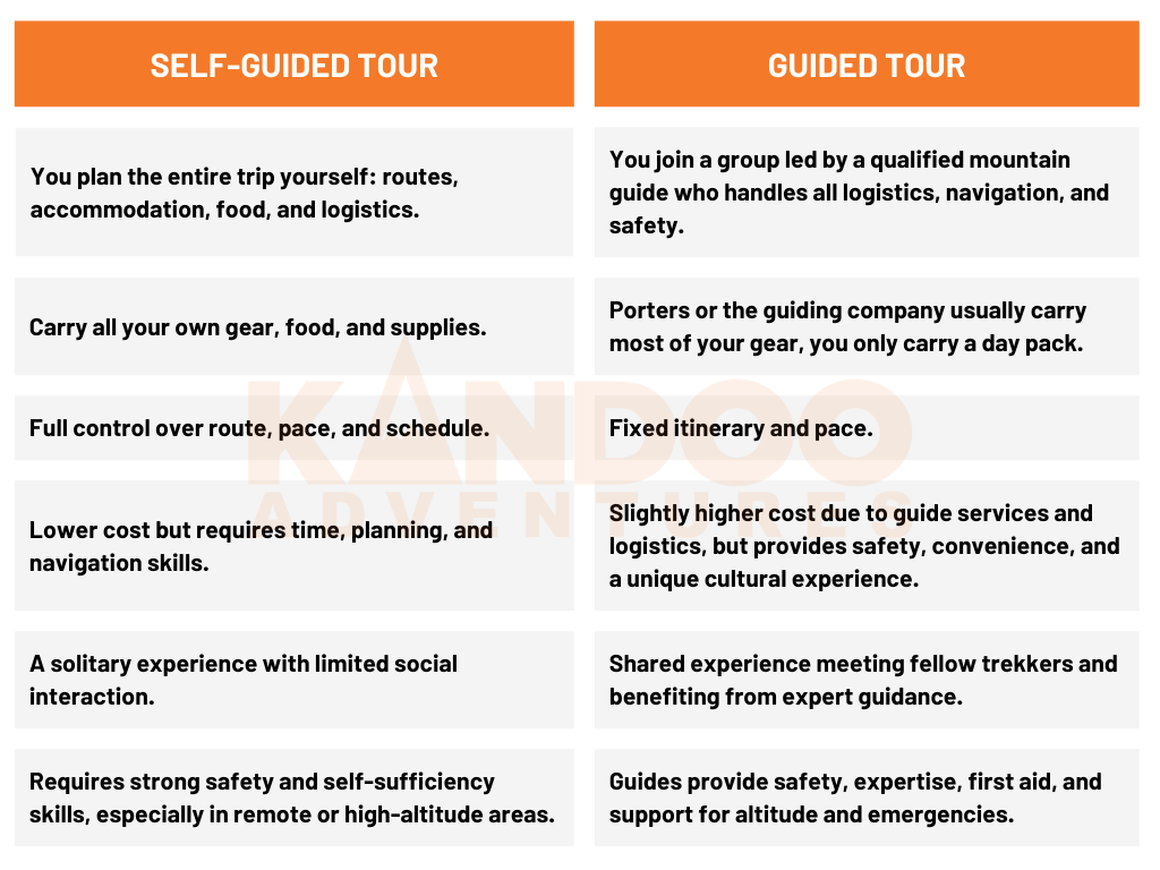
Let’s take a look at these considerations in more detail:
1. Logistics and planning
On a self-guided walking tour, you need to plan every last detail of your trip, including travel to and from the area, organising visas, the route you want to do, and so on.
Planning a self-guided trek is also pretty time-consuming. Studying maps, reading guides, organising food, finding water sources, booking accommodation (or finding spots to camp) – it all takes time, and a lot of it.
With a guided hiking vacation, you don’t have to worry about any of these hurdles. Why? Because it’s all taken care of by the adventure travel company. Even if you love maps and planning, it’s nice to let someone else take the reins once in a while, right?
Here’s what Pietro had to say about booking a pre-planned guided tour with Kandoo:
“The planning and organization was exemplary, with the right balance of structure and some flexibility, ensuring we were prepared to tackle the high altitude sections, whilst enjoying the spectacular views along the way! I look forward to joining another Kandoo adventure in the future.” - Pietro, Trustpilot.
In some places, you also need a guide to hike in certain areas and on specific trails.
Think about trekking in Nepal as an example. To visit certain trekking trails in Nepal (like the Annapurna and Everest regions, as well as for restricted areas like Upper Mustang and Manaslu), the country requires you to have a guide.
The same applies to adventures in Tanzania. If you want to complete a Mount Kilimanjaro hiking tour, you must be accompanied by a licensed guide. Using a guiding company not only ensures you meet these requirements but also makes the process smoother, safer, and far less stressful.
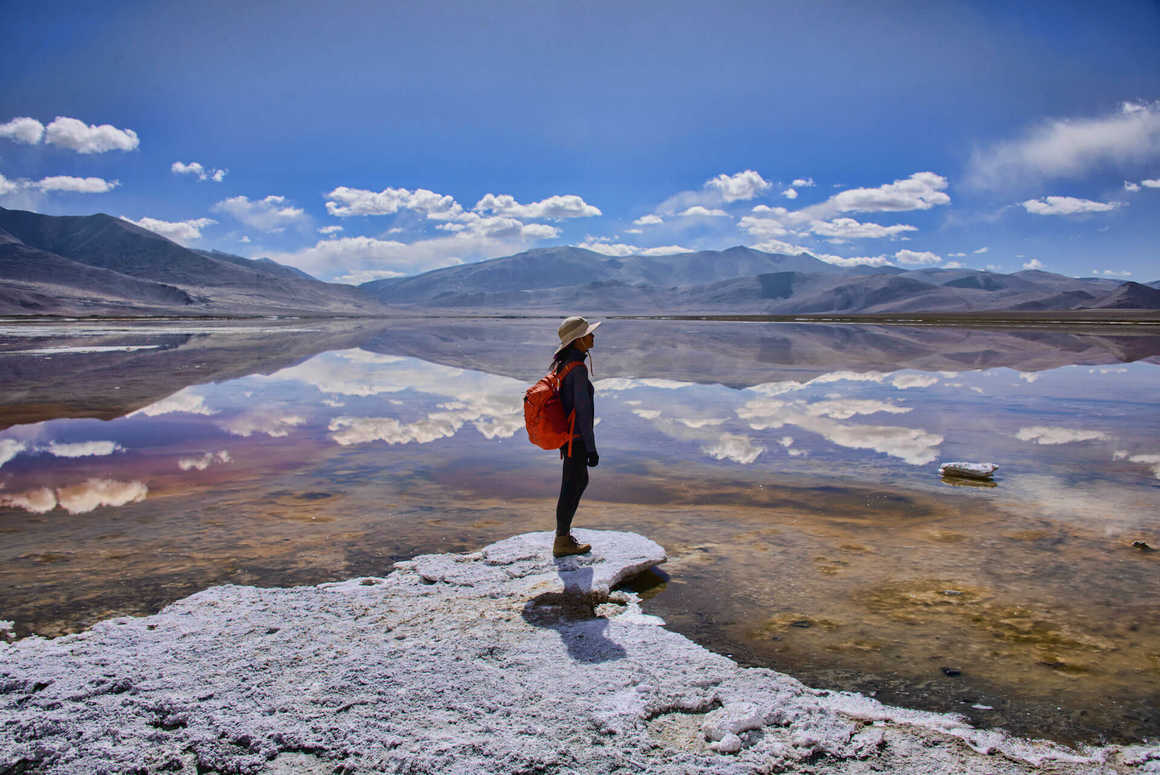
2. Safety and expertise
For some people, having the skills to look after themselves in the mountains is part of the adventure. For others, it can be a little scary.
Heading out by yourself automatically puts you in a riskier position. If you get injured, sick, lost, or run out of food or water, you need to be able to look after yourself. Or if the weather changes at the last minute (which can often happen in mountain terrain), you might find yourself unexpectedly navigating an alternative route.
Elevation is another factor when solo trekking. If you’re doing something at a higher altitude than you’re used to, it’s hard to know how your body will react when you’re up there.
Altitude sickness, for example, can really impact your physical performance. You may feel nauseous, light-headed, fatigued, short of breath and have difficulty speaking or walking.
These are all things you have to consider if planning a solo adventure holiday in the mountains.
Booking a guided trek provides peace of mind when it comes to things like safety, illness, and injury. You book the trip knowing that your guide has all the skills and equipment to handle these tricky situations, which is a weight off your mind when heading out on a big adventure.
Kandoo guides, for example, have:
- A strong understanding of the area. Guides are extremely familiar with most of the trails, terrain, and weather patterns for the areas they operate in, meaning they can choose the safest routes and easily adjust plans when conditions change.
- Top-quality navigation skills. Your guide handles all the navigation, helping you through challenging conditions (if they arise) like heavy wind, rain, snow, or whiteouts.
- Technical skills and experience. Mountain guides and sherpas have technical hiking, climbing and trekking skills, allowing them to support and guide you through various terrain.
- Effective safety management processes. Kandoo Guides follow strict safety protocols for every situation, from evacuations to natural disasters. Their detailed risk assessments identify potential hazards and outline the actions needed to reduce or prevent harm.
- First-aid training. Guides are trained to deliver mountain first aid should any injury or illness occur on the trek. If anything happens while you’re out in the mountains, rest assured that your guide can take care of you.
When it comes to altitude, our guides also monitor each member of the group closely, making sure your body responds well to the change. You receive a daily health check to check your pulse rate, blood oxygen saturation levels, and evaluate your acclimatisation status when trekking at altitude.
Here’s what Hannah had to say about her Kandoo guide who helped people in her group handle their altitude sickness:
“Robert's expertise was second to none! He was so patient and calm even when those who fell ill from altitude couldn't make it, he knew exactly what to do and dealt with it so professionally. His knowledge brought so much ease and trust to the group and we genuinely wouldn't have done so well without him!” - Hannah, Trustpilot
Kandoo’s guides are also trained with the necessary certifications to take you on epic adventures.
Our Nepalese guides, for example, are all members of the Nepal Mountaineering Association. This membership means that guides have passed the "Basic Mountaineering Course", have annual first aid training, and receive specialised training in managing altitude sickness.
For peak climbs, our guides have passed the NMA's "Advanced Mountaineering Course". Most of them are also members of the International Federation of Mountain Guides (IFMGA), the highest standard of guide qualification worldwide.
In other words, if you head out with one of our guides, you know you’re in safe hands.
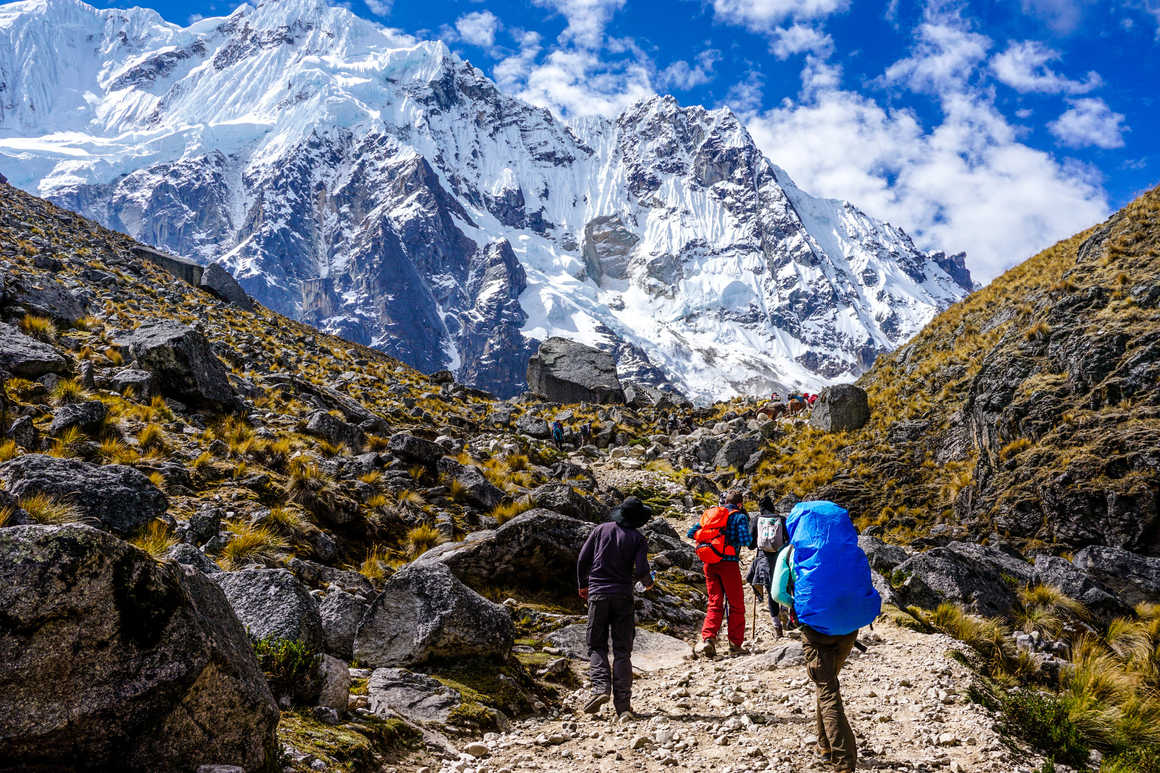
3. Solo or social
On a solo trip, you adventure by yourself. You can go where you want at the speed you’re comfortable with and you don’t have to cater to anyone else’s needs or preferences.
There’s plenty of peace, quiet, and lots of time to enjoy some solitude – if solitude is something you enjoy, that is.
For some people, being alone for long periods of time can be pretty hard. Depending on where you are, you could go days without seeing another person. And even if you do see other people, it might just be in passing. You won’t have the day-to-day interaction of experiencing the adventure with other people.
If being alone doesn’t appeal to you, solo adventures might be challenging. Group adventure holidays, on the other hand, provide social interaction every step of the way.
When you join a guided trek, you spend your days with the same group of people from start to finish. You meet like-minded individuals, swap stories, and build relationships with people that you share an epic adventure with.
You also form a connection with your guide, and that personal bond makes the whole experience even more rewarding. Here’s what Kris had to say about the difference their guide made on the trek:
“My guide, Ugyen, not only provided expert navigation and safety but also brought warmth and positivity, often singing and sharing local culture to uplift my spirit during tough moments” - Kris, Trustpilot.
However, we know that being with the same group of people can be challenging for some individuals – whether you’re an introvert who needs alone time to recharge or you’re in a group with people you perhaps don’t mesh with.
The good news is that this is a rare occurrence. Most travellers who join a guided tour with Kandoo often talk about their experience meeting interesting people and having a great time together:
“I get emotional each time I think about this experience not only because of the sense of accomplishment of climbing a mountain but also because I have met these amazing people and spent some time with them.” - Rushie, Trustpilot.
If you’re sitting somewhere in between wanting social interaction but not wanting it to be too much, don’t worry. Small group adventure holidays are a good middle ground, taking some of the pressure off interacting with a lot of people at once.
And if you still aren’t sure about joining a group of people you don’t know, consider heading out in a private group instead. Rally some friends and book a private guide to have an unforgettable experience with a group of people you know well.
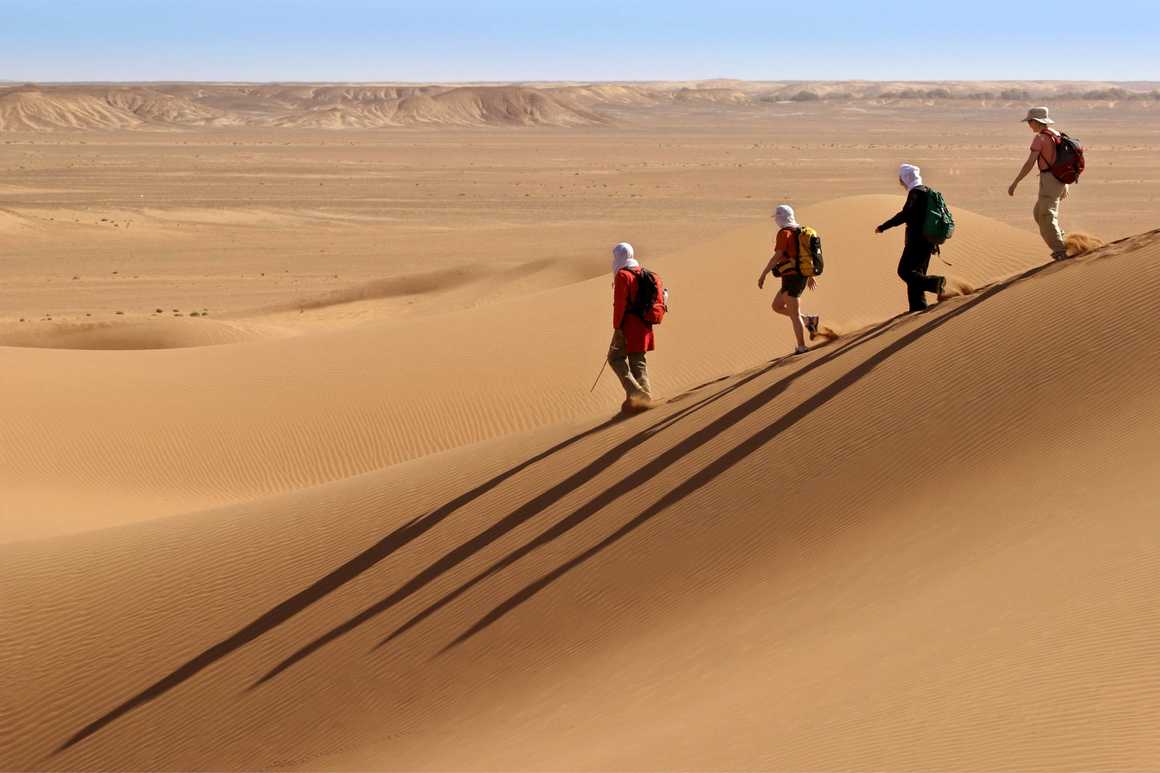
4. Local knowledge and insights
Planning a solo trek offers a lot of flexibility, but there’s a chance you’ll miss out on some really interesting facts and stories from local guides.
Sure, you can do the digging yourself to find the information if you solo trek. There are plenty of guidebooks to choose from and websites to browse! But nothing compares to the in-person experience of a knowledgeable guide. A guide brings the area to life, sharing anecdotes, hidden gems, and local traditions that don’t always make it into print.
Take a look at this feedback from Bradley. On his safari adventure with Kandoo, Bradley’s guide shared his knowledge about the ecosystem and wildlife in Tanzania:
“Tony was an outstanding guide, whose knowledge and insight was invaluable to helping us fully appreciate and understand the amazing ecosystems and wildlife in Tanzania. Tony was engaging, funny, and safety minded, and wowed us with his knowledge of animal behavior.” - Bradley, Trustpilot.
Having these additional insights transforms a trek from simply reaching your destination into a richer, more meaningful journey.
And as we’ve already mentioned, local guides know the area you’re exploring inside out. As a result, they can take you to new and interesting places that you might never have seen otherwise.
So even if you’re capable of independently walking the route, guided treks should still be on your radar. Local guides enrich the trip with stories, history, and traditions that you’ll struggle to find in guidebooks, connecting you to the culture and environment in new ways.
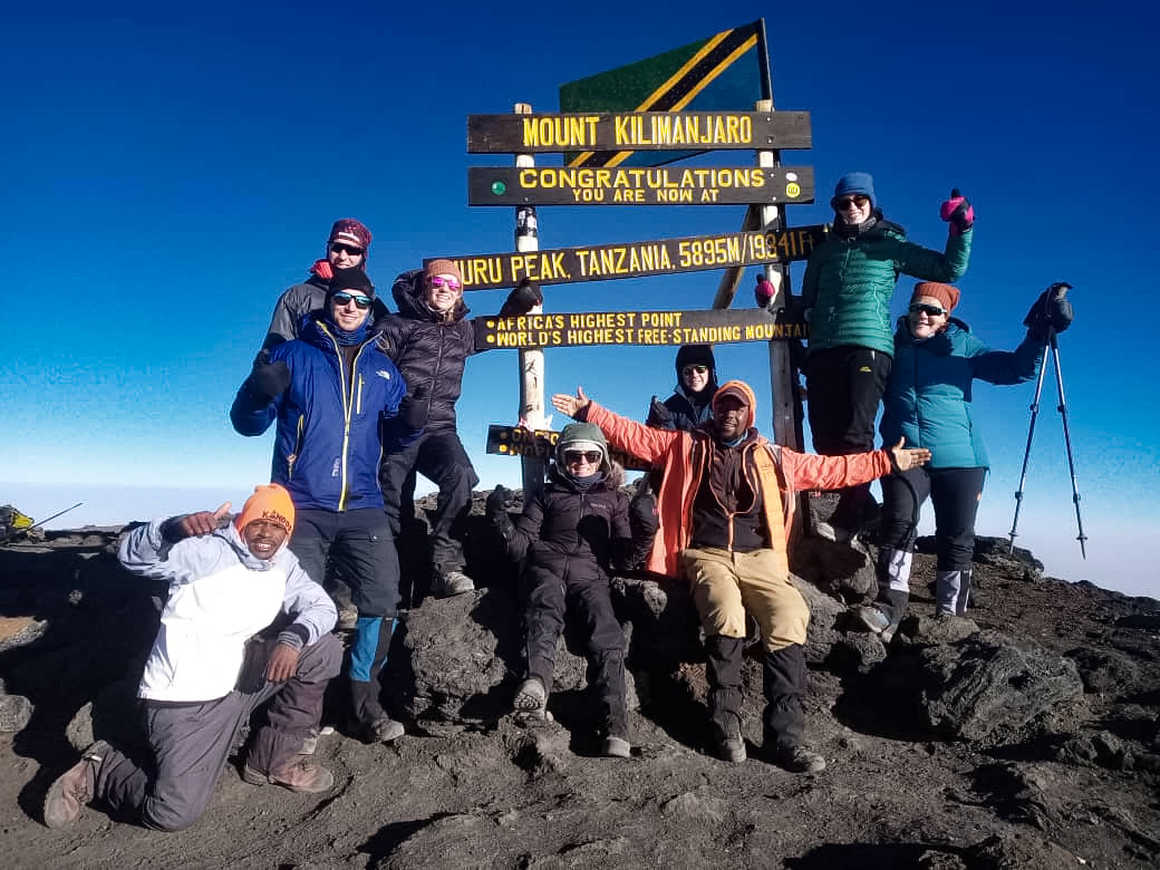
5. Carrying your own gear
When planning solo adventure travel, you typically carry all of your belongings on your back every day – unless you arrange for a porter to transfer items for you (which is another logistical consideration).
If the idea of carrying a pack with all your gear, food, cooking equipment, and clothing sounds like fun, a self-guided trip fits the bill. But if this sounds like your worst nightmare? A guided trek is probably the better option.
For most guided hikes, you’ll carry a day bag with food items for the day, spare layers, and water. However, the bulk of your items (like sleeping bags, extra clothes, and so on) are carried for you from location to location.
In other words, you leave one location in the morning, hike throughout the day, and arrive at the next location to find your bag already there.
Not only does this make the day-to-day activity of the trek easier and more comfortable, it’s one more organisational hurdle you don’t have to think about.
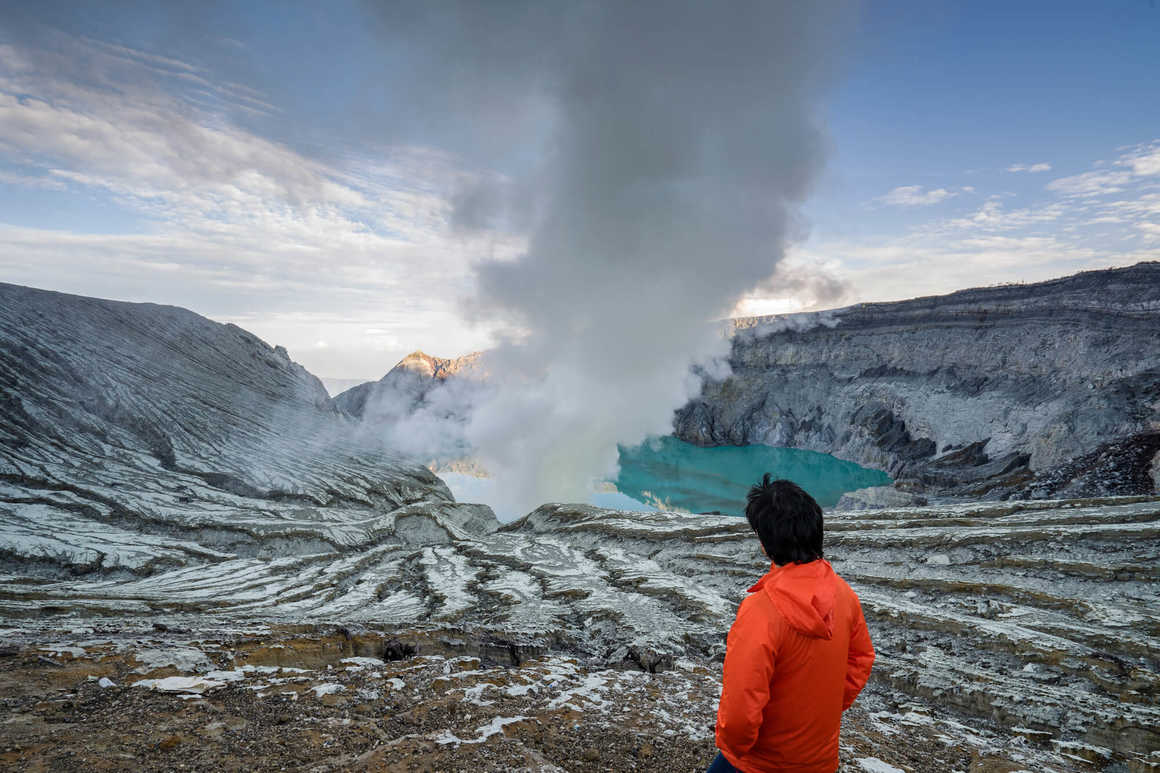
6. Pricing and costs
If you’re hoping to summit a mountain or complete an expedition on a budget, self-guided hiking tends to work out cheaper.
You plan and pay for everything yourself, without needing to hire a company or a guide. This means you can choose cheaper options for things like food, accommodation, and so on. As a result, your overall costs are usually lower.
However, there’s a reason that guided trips are usually more expensive – you get a lot for your money.
Beyond the logistical planning and expertise of a local guide, guided trips provide convenience, safety, and peace of mind. When you book the trip, you know that every element is taken care of.
Plus, if you manually book every part of your trip, there’s a chance something might slip through the cracks. Booking flights, transfers, accommodation, food, refuges, huts, and campsites is a lot of admin.
With a guided trip, you don’t have to worry that you haven’t booked a key part of the trip or that you’ve booked something incorrectly.
You can often split the costs of a guided trip to make it more affordable. With Kandoo, we take a 20% deposit when you book the trip. The final payment is due 60 days before departure, helping you spread the cost to pay for your dream trip without breaking the bank!
Fun fact: From time to time we may offer low deposits so you can secure your place on a big bucket list trip with a small financial commitment. Follow us on social media to keep up to date with our latest offers!
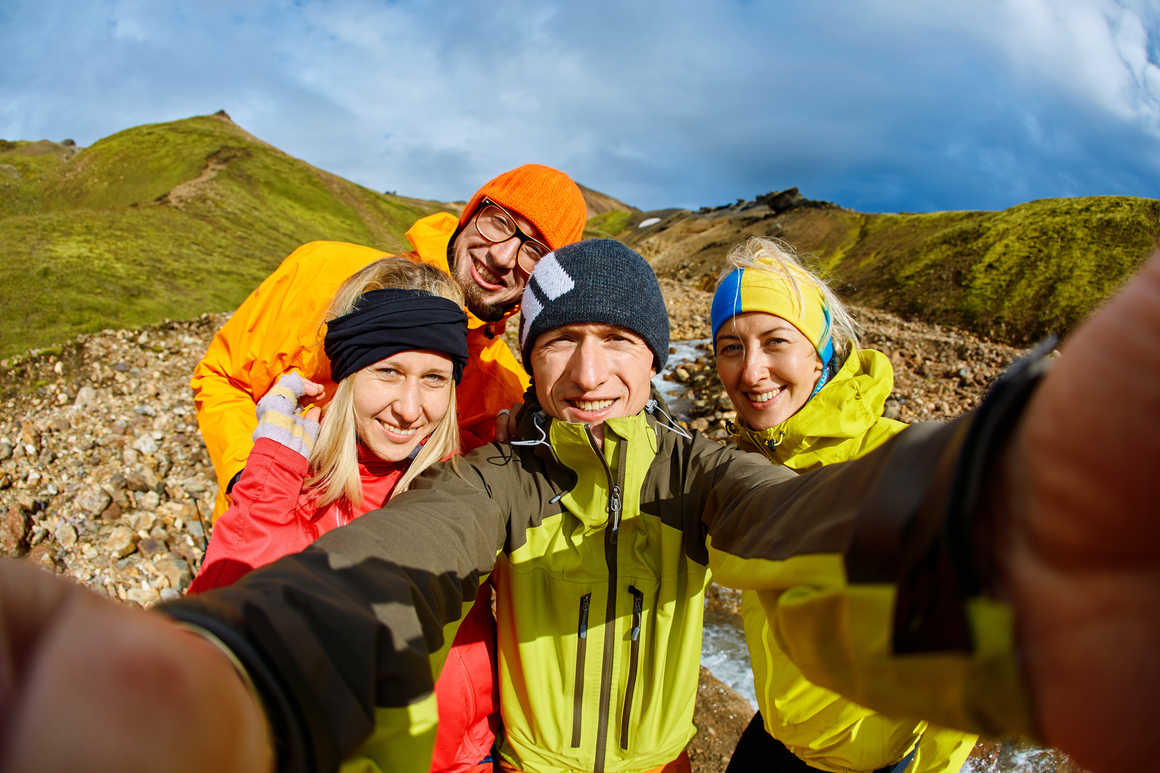
Should you do a solo or guided trek?
Choosing between a solo or guided trek depends on what you want from your trip, how much time you want to spend planning, and your budget.
If you’re looking for convenience, a shared experience, and valuable local insight, a guided trek is the right choice. Reach out to Kandoo’s friendly team of travel experts to spend less time planning the adventure and more time having it!
